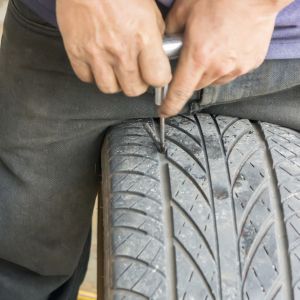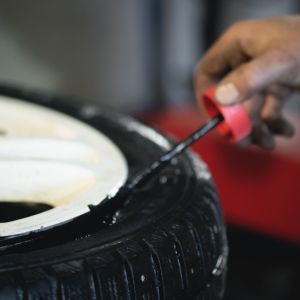Tyre sealant is a liquid solution made from latex, fibres and other ingredients designed to help seal punctures in a tyre and prevent further air loss. It is usually stored in a bottle or aerosol can and is applied through the valve stem of the tyre. The sealant is designed to seal small punctures as they happen and help maintain the pressure in the tyre for a short time. Now, we’ll delve into the advantages and drawbacks of using tyre sealant, offering you a clear understanding of whether it’s the right choice for your driving needs.
The sealant is designed for tubeless tyres and works by filling the puncture and hardening, sealing the hole and preventing air from escaping. Some tyre sealant also contains a balanced liquid to keep the tyre balanced. It is a convenient solution for on-the-go repairs, as it allows the driver to continue driving on a punctured tyre until it can be properly repaired.
When and why to use the tyre sealant

Tyre sealant is used as a preventative measure to seal small punctures before they cause a flat tyre. The most common reason to use tyre sealant is when you have a puncture in your tyre and don’t have the time or access to get a replacement or repair. It’s a very effective way of extending the life of your tyre, as the sealant seals the puncture, preventing air from escaping and making the tyre last longer.
Tyre sealant works best on small punctures or cuts, as it is not suitable for large holes. It can also be used to stop slow leaks in tyres and to temporarily repair a tyre until a permanent repair can be made.
Another situation where tyre sealant can be used is if a vehicle is stuck in mud or sand, as the sealant can be used to increase the tyre pressure, providing better traction and helping to get the vehicle out of the stuck position.
Advantages of using tyre sealant

The following are the advantages of using tyre sealant:.
- Convenience: Tyre sealant allows you to continue driving on a punctured tyre until it can be fixed correctly, making it a convenient option for on-the-go repairs. As a result, you won’t have to deal with the hassle of changing a flat tyre on the side of the road.
- Cost-effective: Tyre sealant can help extend the life of a tyre by sealing small punctures and preventing air from leaking, which can help reduce the cost of tyre maintenance. This can help save money by preventing the need to buy a new tyre too soon.
- Easy to use: Applying tyre sealant is a relatively simple process that can be done by the driver, with no need for professional assistance.
- Long-lasting: When used in the recommended amount and frequency, tyre sealant can last for several months, providing ongoing protection against punctures.
- Versatile: Tyre sealant can be used in a variety of vehicles, including cars, trucks, motorcycles, and bicycles, making it a versatile solution for tyre maintenance.
- Environmentally friendly: Tyre sealant is a non-toxic solution that can help reduce the number of tyres that end up in landfills. By prolonging the life of a tyre, it helps to reduce the number of tyres that need to be replaced, which can have a positive impact on the environment.
Disadvantages of using tyre sealant

The following are the disadvantages of using tyre sealant.
- Not a permanent solution: Tyre sealant is not a permanent solution for a punctured tyre. It is meant to be a temporary fix, and the punctured tyre should be properly repaired or replaced as soon as possible. You can get flat tyre repair services for a permanent solution.
- Can clog the valve: If not used properly, tyre sealant can clog the valve. It can prevent the tyre from properly inflating, causing issues with tyre pressure and performance.
- Can dry out over time: Tyre sealant can dry out over time, reducing its effectiveness. This means that it may not be able to seal new punctures as they occur.
- Can’t be used on certain types of punctures: Tyre sealant cannot be used on sidewall punctures, punctures larger than 6mm or damaged tyres.
- Can cause vibration: If tyre sealant is not distributed evenly within the tyre, or if it is overused, it can cause vibrations and affect the handling of the vehicle.
- Can be messy: Applying tyre sealant can be messy, and it can be difficult to clean up if it gets on clothing or other surfaces.
- Cannot be used on all types of tyres: Tyre sealant is specifically designed for use in tubeless tyres, but it may not be compatible with other types of tyres.
- Need to be replaced regularly: Tyre sealant needs to be replaced regularly, otherwise it will lose its effect and the tyre will be in danger.
Before deciding whether tyre sealant is the best option for your vehicle and driving habits, it is critical to weigh the benefits and drawbacks.
Frequently Asked Questions
Q1. What are the benefits of tyre sealant?
Ans: The benefits of tyre sealant include the ability to seal punctures quickly and prevent flat tyres, making it a convenient solution for on-the-go repairs.
Q2. Is sealant good for tubeless tyres?
Ans: Because it can seal punctures without the use of an inner tube, sealant is intended for use in tubeless tyres.
Q3. What is the disadvantage of tyre sealant?
Ans: One disadvantage of tyre sealant is that it can dry out over time, reducing its effectiveness. It can also clog the valve of the tyre if it is not used properly.
Q4. Does tyre sealant ruin the tyre?
Ans: Tyre sealant does not ruin the tyre if it is applied at an adequate amount.
Q5. What can I use instead of tyre sealant?
Ans: Tyre inflator is an alternative to tyre sealant, which can be used to repair punctures.
Q6. Can tyre sealant cause vibration?
Ans: If tyre sealant is not distributed evenly within the tyre or is used excessively, it can cause vibration.

